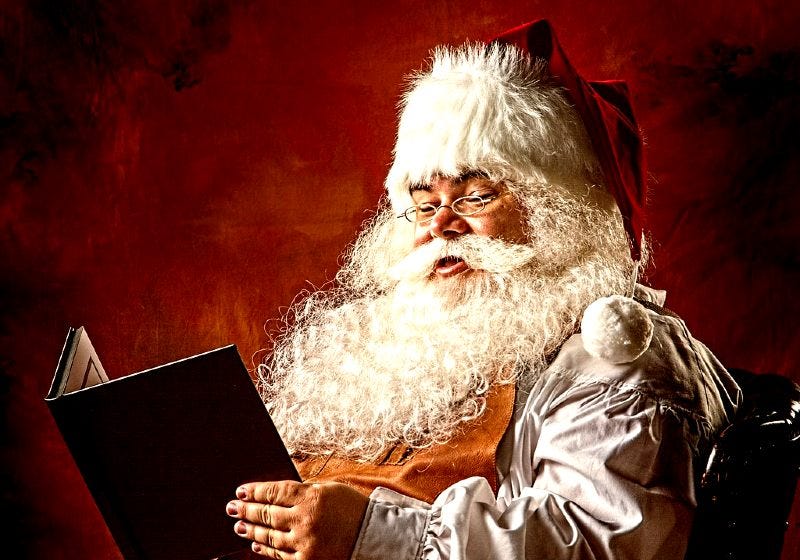Believe it or not, Santa Claus is a religious symbol. Unfortunately, he’s been made into a pagan by the secular culture. Poor Santa.
But his religious meaning far transcends the plump figure who travels around the entire world one night a year in a sleigh pulled by reindeer.
I learned of Santa’s religious symbolism from a fantastic sermon I heard sometime in the ’90s. It stuck in my mind because sermons in Catholic churches are generally so…so…to be charitable—uninspiring—even at Christmas (but “Who am I to judge?”)
This one, however, was very good. I’ll see if I can do it justice in the retelling.
The sermon
The setting was Midnight Mass in a packed church. When the priest finished the Gospel reading, he began his sermon this way:
“That jolly fat guy in the red outfit with white trim is not a legend. He’s a myth.”
Awkward silence. A few confused expressions on faces around me (mine included) indicated that people thought this was going to be another hipster sermon debunking our cherished traditions.
But that wasn’t what it turned out to be. The rest of the priest’s sermon went something like this:
A legend is a story for children. A myth is a story for adults.
(Now he had our attention.)
A legend is rarely based on anything historical but aims to give a moral or practical message without much or any historical reality. Think of Grimm’s fairy tales or Aesop’s fables with all their talking animals and shenanigans.
A myth, on the other hand, takes some historical truth and brings out its deeper meaning. Our familiar Santa Claus is that type of myth and is much more than meets the eye. Let’s start with the historical fact on which Santa is based:
The name Santa Claus is the English version of the Scandinavian name, Sinter Klaas, which in turn is the Nordic way of pronouncing “Saint Nicholas”, who was a real person. And he was holy. So far, so good.
History tells us that St. Nicholas was the bishop of Myra in Turkey in the 4th century AD. He is well-known for having punched a heretic in the nose at the Council of Nicea in the year 325. That part may or may not be historical, but it does indicate that bishops at one time actually took heresy seriously. But I digress.
Bishop Nicholas also saved a few falsely-accused prisoners from execution by ordering the Emperor Constantine to set them free. He is also supposed to have performed many miracles during his life, including preventing a few shipwrecks by his prayers.
Old Saint Nick was no shrinking violet, that’s for sure. I don’t know of anyone who could give orders to an emperor and get away with it.
But these items are not why he is the saint of Christmas. According to the historical record, Bishop Nicholas also saved three girls of his diocese from being sold into slavery to pay off their father’s debts.
The good bishop did this by throwing three bags of gold through the window of the family’s home and then running away so that no one would know that he was their benefactor.
***(As an aside, if I may: Anyone wishing to donate a bag of gold to the parish this evening is kindly asked to refrain from throwing it through the rectory window. You may, however, deposit your donation in the collection plate at the Offertory for maximum convenience. Thank you very much.)***
Happily, Bishop Nicholas’ donation worked to save the young ladies from an awful life, but his act of charity was so great that he couldn’t remain anonymous as he wished. The universal Church has remembered his goodness for centuries now.
So, in essence, Santa Claus was once a living, breathing, courageous, generous, and humble person who is considered the patron saint of children, condemned prisoners, shipwrecked sailors, damsels in distress, and gift-giving at Christmastime.
And to think that he was actually a Catholic bishop!
Then Father added: “And this is why Santa Claus wears a pointy hat.”
He went on to explain that Santa’s hat symbolizes a bishop’s miter (that odd pointed hat that bishops wear in ceremonies). The two points are supposed to resemble the flames of the Holy Spirit that descended on the apostles on the day of Pentecost.
We could easily miss the religious symbolism of the hat because the mythical Santa’s hat generally droops and has a cotton ball on the end of it, more resembling that hat of an elf hat than a bishop’s miter.
That’s the secular version anyway.
The myth
The adult myth of Santa includes a great deal of beautiful religious symbolism if you look closely. In fact, he’s like a living image of the Holy Trinity:
As already noted, his charity as bishop symbolizes the fire of God’s love that descended with Holy Spirit, but there’s more...
The colors of red and white on his wintery costume signify the two natures of Jesus Christ – divinity and humanity – and they can be taken as symbols of the blood and water that flowed from His side on the Cross. (Incidentally, the red-and-white-striped candy cane is also supposed to resemble a bishop’s staff. How about that?)
Santa Claus is also the quintessential image of God the Father.
His metaphorical resemblance to the goodness of the Father is the prime symbol of the myth, which brings out the deeper meaning of his character that no Hollywood movie could ever display adequately. Santa’s fatherly characteristics constitute a whole theology lesson.Santa is omniscient:
As the song says, “He sees you when you’re sleeping and knows when you’re awake. He knows when you’ve been bad or good, etc. etc.” Similarly, nothing is hidden from God, and, like any good father, He expects you to be on your best behavior at all times.
He is omnipresent:
Poor old Santa has to hop in a sleigh to get around the world in one night, but the Creator of the world needs no such transportation. He’s everywhere, and we all have direct access to Him at all times. (You have to admit, though, that Santa making all those stops in one night is pretty impressive.)
He is full of goodness and joy:
We all know from the stories that Santa is a jolly character with a pretty hearty laugh. Looks to me like he’s smiling all the time too. That’s a great image for the Father’s eternal goodness!
Analogously, the Father gives every possible gift to His children and loves each of us as if we were His only child. All He requires is love in return, which is apparently symbolized by the token offering of milk and cookies at the bottom of the chimney. And…
He lives in a magnificent but mysterious far-away home:
For Santa it’s the North Pole, which is really mysterious because there’s no actual land mass there! Hmmm. But Jesus promised that His Father’s heavenly home is much more magnificent with a mansion for each person. I’d actually settle for a one-room apartment if I ever make it there.
Santa’s little helpers who have some kind of preternatural talent for making fascinating gifts are pretty clear metaphors for angels.
And his majestic reindeer—well, they could be symbols of the most glorious of the angels. In the Old Testament, the Lord is “enthroned on the wings of Cherubim”, which is a metaphor that carries over to the Book of Revelation, further proving that there’s probably a method to this mad myth.
We could tease out much greater symbolism in Santa, but time is short, and I’m sure all my intelligent readers get the point.
Radiant goodness
According to what we’ve just said, Santa Claus is the picture of Goodness incarnate, a meaningful myth of God the Father, dressed up in festive garb every winter. Too bad the secular world has turned Santa into a Grinch or a buffoon or a sort of benign capitalist who doles out material gifts like there’s no tomorrow.
If your image of Santa is the secular version, you not only miss the beautiful symbolism, you also miss an opportunity to teach your kids the true meaning of Christmas. And eventually, you have to break the bad news to the kids that the secular Santa isn’t actually real.
But God most certainly is.
However, if you believe that Santa is a rich and meaningful symbol of the personal goodness of God, the kids will grow up understanding the truth of Christmas and quite a lot about the reality of God the Father’s goodness, which culminates in His giving the greatest Gift ever: His Son.
And you won't ever have to disappoint them by shattering a childish secular legend. The religious story easily transforms into the meaningful myth as they grow.
In other words, Santa Claus is a sacred window into the nature of God.
Not bad for a guy with a pointy hat.
[And a Merry Christmas Season to all, including this grumpy Santa cat, or should I say, Santa Claws?]










I really enjoyed reading this like a child. Very impressive details and humor in between the lines.
Well done. As an aside, don't forget Rev. 19:11 - Not quite a reindeer but much faster!